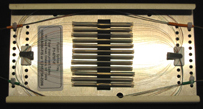|


Press
the "Forward" button to continue.
Testing |
Splice Protection and Testing |
Whether fusion or mechanical, once
the splice is assembled, it must be protected
from moisture and movement within an enclosure. |
 |
Whether fusion or mechanical, splices
should be tested with a loss meter or OTDR for quality.
After testing, the splice should be mounted in a
proper splice holder or tray. The splice holder
should be firmly secured within a enclosure.
Splices
must be protected against vibrations. Mechanical
splices may work loose or become high loss after
excessive vibration.
|
| Fibers
must have all outer jacket and strength member materials
removed before splicing. 900 micron or 250 micron
buffered fiber strands are quite delicate, and excessive
bending of these fibers can result in high loss.
Often these bends occur within the splice enclosure.
Once completed, splices should be tested, and carefully
placed into their holders, without excessive bending
of the fiber strands. |
|
|
| LESSON
REVIEW |
Key
Points:
1.
Once completed, all splices should be tested.
2. Splices require protection from environment and vibration.
|
Pop
Quiz:
True or False
Fusion splices do not require testing.

|
|
|
|
|
| |
|
|
|
|
 |
|
|
|
|
|
|
|


